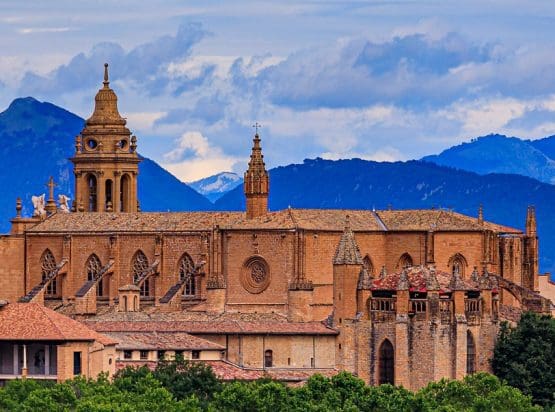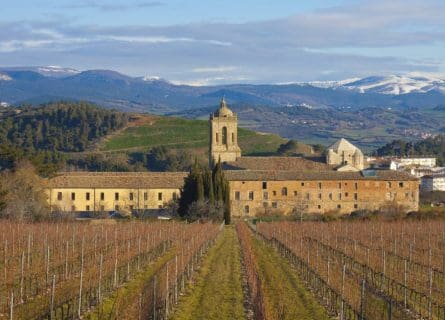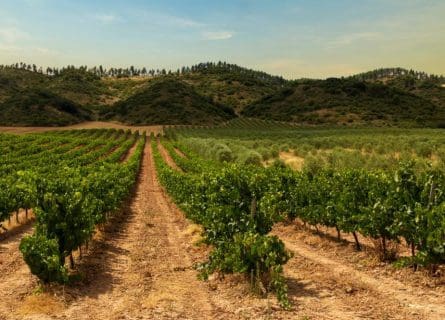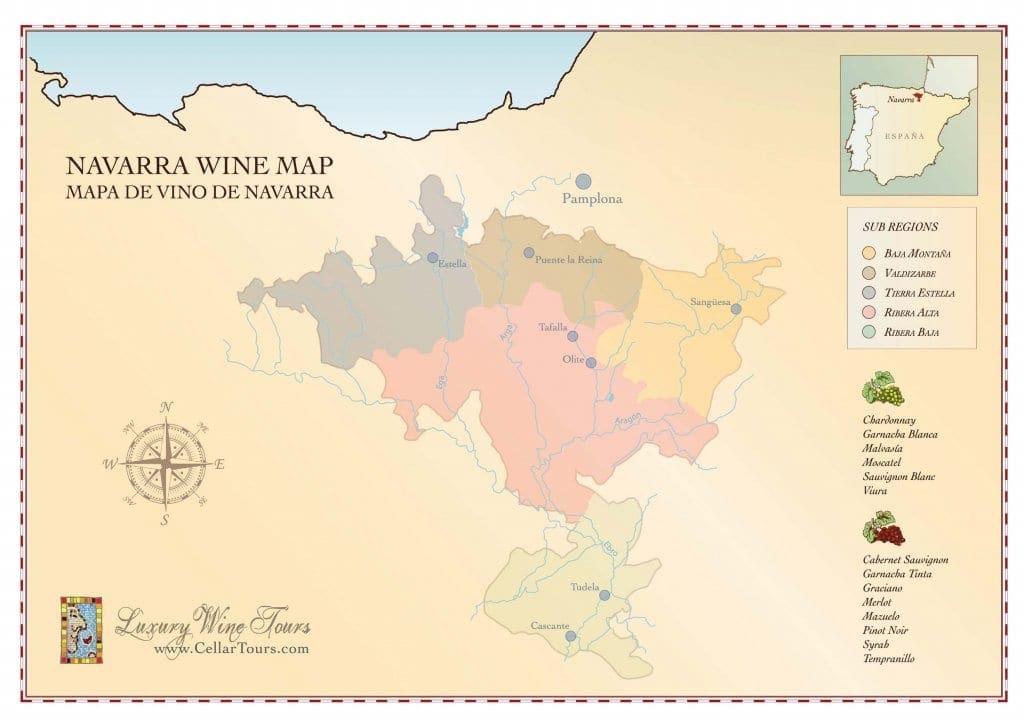Immerse yourself in Pamplona's vibrant flavors and uncover hidden culinary gems with our expert insider guides. Plan an unforgettable trip today!
Read more
EXPLORE ALL OUR BASQUE COUNTRY WINE REGIONS GUIDE
Last updated: September 11, 2024
With all the excitement concerning Rioja and Ribera Del Duero, Navarra’s superlative red and white wines are sometimes unwisely overlooked. Indeed, while the vast majority of oenophiles could name at least 5 Riojan bodegas at the drop of a hat, turning our attention to Navarra would undoubtedly present a greater challenge. Yet this is the world’s loss, for Navarra is one of the great unsung heroes of Spanish winemaking, offering excellence and astonishing value in equal measure.
However, there are tentative signs that the international community is taking these diverse wines more seriously. For one thing, outside investors have caught a whiff of the area’s enormous potential, not least the Artadi family, who own a brilliant label called Artazu. Pago de Larraainzar, meanwhile, is a glamorous star in this up-and-coming vineyard; Bodegas Chivite continues to make a range of excellent wines based on a judicious mix of indigenous and international varieties. So, there is no doubt that Navarra has spent far too long in Rioja’s shadow. It’s time for the region to stand proud and share its fantastic story.
Discover more about Spanish Wine

This is an ancient land with a long history of viticulture. In the 2nd century BC, the Romans planted the first vines following their conquest of the Iberia Peninsula. They initially established vineyards to the south of the Pyrenees Mountains, along the fertile banks of the River Ebro. Over time, they spread out in all directions from the regional capital of Pamplona to the southern border of Navarra, neighboring Aragon.
Yet Roman hegemony collapsed in 476 AD, paving the way for centuries of chaos: winegrowing became a victim of political turmoil and countless battles in the Dark Ages, not least because rival powers greatly coveted agricultural land. Finally, in 711, the Moors claimed the peninsula as their own, naming this vast territory ‘Al Andalus.’ Despite losing certain territories, their civilization endured in Andalucia for over six centuries, renowned for its advancements in astronomy, navigation, medicine, and architecture.
Christian Kingdom of Navarra
However, Navarra emerged as an independent Christian kingdom as early as the 900s, after Sancho Garces I became king of Pamplona. Sancho III the Great subsequently expanded the kingdom, pushing the Moors out of northeastern Spain in a series of bloody battles. After Sancho III died in 1035, Navarra stretched from Aragon to Valladolid.
Fernando II of Castile annexed Navarra in 1512, although the region retained its laws and currency until the 1800s. This newly united country enjoyed unprecedented wealth and prosperity, much of it taken from the New World. Meanwhile, wine growing once again became a vital part of the economic and cultural life of Navarra—pilgrims traveling on the Camino de Santiago route notably held Navarra’s wines in high regard during the Middle Ages.
Sadly, the arrival of phylloxera at the end of the 19th century devastated the vast majority of Navarra’s vineyards, killing over 90% of the region’s vines. Yet all was not lost, and at the beginning of the 20th century, like most of Europe, growers replanted their vines with phylloxera-resistant rootstock from the US. Nonetheless, the goal from the outset was to turn Navarra into a bulk wine region—the quality was not on the agenda, and the wines were of little merit.
Modern Revival and Transformation
Its modern transformation began relatively recently in the early 1990s, when a younger generation of globe-trotting winemakers adopted a new approach, bringing a more international outlook and fresh ideas to Navarra’s wines. This firmament – winemakers such as Adriana Ochoa of Bodegas Ochoa – has continued to drive ever-increasing improvements in wine quality. Once derided (justifiably) as a region of cheap jug wine, Navarra is now proving its ability to make characterful, terroir-driven wines at highly competitive prices.

Navarra’s vineyards are in northeastern Spain, a beautiful and undulating region bordering the Basque Country, Rioja, and Aragon. Indeed, Navarra is a paradise for outdoor enthusiasts: the Pyrenees offer skiing in winter and climbing, hiking, and canoeing the rest of the year.
It is also one of the most heterogeneous vineyards in northern Spain, with marked differences in soil, mesoclimate, and elevation. Today there are nearly 18,500 hectares under vine in Navarra, spread over the five subregions of Tierra Estella, Valdizarbe, Baja Montaña, Ribera Alta, and Ribera Baja.
If you visit Navarra, it soon becomes apparent that there is a great deal of difference between the hot, dry, and flat Ribera Baja and Ribera Alta subzones in the south and the less-planted, cooler terroirs of the north. Bathed in endless sunlight, Ribera Alta is ideal for cultivating Rhone varieties – particularly Grenache and Syrah. Protected by the Sierra del Moncayo, Ribera Baja serves as another Grenache hotspot: experts often say the finest climats (vineyard sites) reside in the poor, Chateauneuf-like soils of Fitero, a subzone within a subzone.
Unique Climate and Soil Variations of Northern Navarra
However, Tierra Estella, Valdizarbe, and Baja Montaña represent a whole other world; a baking-hot day in the south can be relatively cool in the mountainous north, closer to the Atlantic. Moreover, this part of Navarra is far wider than the southern section – the western fringes are within striking distance of Rioja’s capital Logroño.
Like Rioja, northern Navarra’s altitude means that late-ripening varieties – most noticeably Cabernet Sauvignon – are picked later than in Bordeaux itself; the harvest can occur in November in the highest vineyards. In terms of soils, clay and limestone are the norm here, in addition to alluvial matter and some metamorphic rock. Site selection, as elsewhere, is of paramount importance in Navarra.

Getting to grips with Navarra’s classification framework is remarkably easy. A single appellation in this expansive region, Navarra DO, covers the production of white, red, and rosé wines. As of 2023, the terroir movement and growing fixation on vineyard delineation have (yet) to make serious inroads into the hills of Navarra. But the drive to improve quality and, more importantly, to express the nuances of Navarra’s eclectic terroirs is occurring across the region.
For most of the 20th century, growers in Navarra’s vineyards dedicated themselves to producing a great deal of Grenache, which they used to make potent reds and luscious rosé. It was a wise decision: the great red grape of the southern Rhone shines in Navarra’s calcareous soils, yielding perfumed wines with bright fruit and irresistibly crunchy acidity.
The best bottles, such as Chivite’s Gran Feudo Vinas Viejas Reserva (a blend of old Tempranillo and Grenache vineyards), offer deep complexity and a profound sense of place. They are every bit the equal of ‘First Growth’ Chateauneuf du Pape.
Diversity and Evolution
However, that is not to suggest that Navarra is a one-trick pony. Far from it – growers in the region plant a large cross-section of Spanish and international varieties, including Tempranillo, Cabernet Sauvignon, Merlot, Graciano, Viura, Malvasia, and Chardonnay. Winemakers produce some of Spain’s finest Chardonnay here: structured and refined with the opulence of Premier Cru Meursault. Of course, not every wine made in Navarra electrifies the palate – sizable co-operatives still account for much of the region’s pedestrian output.
But the number of world-class bottles is constantly growing as businesses realize that the future of cheap plonk is dwindling as Western consumers embrace the mantra of ‘drinking less but better.’ The most critically-lauded wines of Navarra share a few strands of common DNA, despite the variety of grapes planted in the region, namely finesse, elegance, an ability to age, and the sense that it could only have been produced in Navarra.

What does a typical wine from Navarra smell and taste like? That’s a challenging question; the region sets its stall on diversity rather than producing one signature wine style like Chablis or Cava. As a result, Navarra can offer everything from Tempranillo-based reds with more than a whiff of Rioja about them (often at lower prices) to oak-infused Chardonnays reminiscent of top Burgundy. Indeed, Navarra’s astonishing diversity makes it unique in Spanish winemaking, and some superb value wines can be found across this complex and varied region. Of course, dross sits alongside quality, but Navarran wines are truly fantastic value at their best quality.
Exploring Navarran Wines
So, where should the curious oenophile start looking? Bodegas Julian Chivite is an excellent place to begin any Navarran journey. It is an ancient producer founded in the 17th century and is still family-owned. The bodegas’ vineyards are all in the northernmost Tierra Estella region, and the consistency of quality across the board is remarkable, mainly in the Coleccion 125 range. Their 125 Chardonnay is among the best in its class and regularly ranks alongside the finest Spanish whites being made today. Other wineries like Domaines Lupier focus more exclusively on indigenous varieties such as Garnacha, arguing that ubiquitous grapes such as Chardonnay and Merlot have no place in Navarra. Yet the quality of Navarran Cabernet can astound – an equal to top Pauillac.
But, if time is short and the options are many, the discerning oenophile will usually plump for one of Navarra’s exceptional Grenache wines. The purity of fruit, sophisticated tannins, and textbook acid line that characterizes these wines cost ten times as much in the hills of Priorat. So the question is: why pay more for perfection?
Chardonnay is a green-skinned grape varietal native to the Burgundy wine region in France and one of the most popular varieties worldwide.
Find out moreDiscover the Allure of Grenache Blanc: Full-Bodied White Wine from Northeastern Spain. Experience the Richness of High Alcohol, Low Acidity Wines.
Find out moreExplore the allure of Malvasía de Rioja grape. Uncover its origins, tasting notes, and its contribution to the exquisite wines of Rioja.
Find out moreThe sauvignon blanc grape varietal, originally from the Bordeaux region of France, is now one of the world's most loved white varieties.
Find out moreDiscover Viura: Rioja's Prominent White Grape & Catalonia's Macabeo. Explore its versatility in exquisite wines. A must-read for wine enthusiasts.
Find out moreDiscover the irresistible allure of Cabernet Sauvignon—a worldwide favorite with robust, dark-bodied flavor. Unleash your wine journey today!
Find out moreGarnacha: Spain's Red Gem. Akin to Pinot Noir, it bridges terroir and winemaking, crafting captivating expressions.
Find out moreGraciano is a red grape variety that is primarily grown in Spain's Rioja region. Known for its thick skins, small berries, and low yields, this grape produces wines that are deeply colored, highly tannic, and full-bodied, with a range of aromas from dark fruit to spices and leather
Marzuelo grape is a red wine variety primarily grown in Spain, particularly Rioja, and Navarra. Its small, thick-skinned berries produce deeply colored wines with a rich, full-bodied taste and intense black fruit and spice aromas
Merlot is the most cultivated grape in Bordeaux and closely related to Cabernet Franc
Find out morePinot noir is a light-bodied red wine varietal closely related to the Vitis vinifera grape and produces the most sought-after red wines in the world.
Find out moreSyrah is dark-skinned and perhaps the most underrated of the 'noble' red grape varieties.
Find out moreDiscover Tempranillo: Spain's iconic red grape. From Ribera del Duero to Toro, it yields concentrated wines. Explore its synonyms and unleash its prowess.
Find out moreDinner time is the highlight of any trip to Navarra. Ensure you arrive hungry: chefs don’t believe in bijou portion sizes and overly elaborate culinary wizardry. Hearty, fresh food is what it’s all about; the most iconic dish is the “caldereta,” which is meltingly tender lamb stuffed inside a ‘gutted’ potato, served with a rich tomato sauce. Meat features heavily in Navarra, where farming is a major part of the local economy.
In addition to lamb, you can feast on wild game, suckling pig, and rabbit in the many excellent restaurants of Pamplona, where good food is rarely expensive. Navarra is also famed for its locally grown white asparagus and for supplying the country with spicy pimiento piquillo.
A Gastronomic Guide to the Cusine of Basque Country: read more
If you would like us to customize an exclusive luxury tour, contact us and let us know your travel plans. We offer luxury food and wine tours for private groups of a minimum two guests. In addition, all of our private, chauffeured tours are available year-round upon request.

